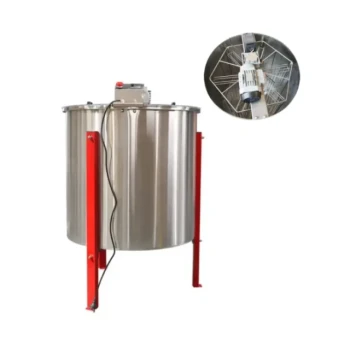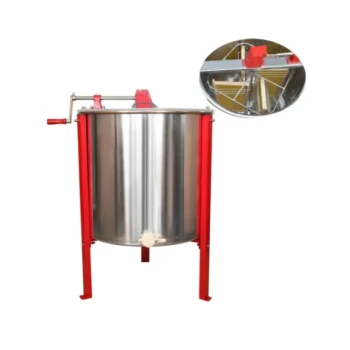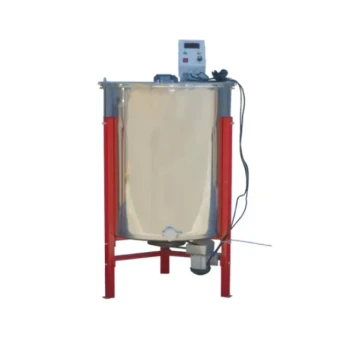At its core, processing honey requires equipment to uncap the wax-sealed comb, extract the honey using centrifugal force, and strain it to remove debris before bottling. For a small-scale operation, this can be as simple as an uncapping tray, a small extractor, a food-grade bucket with a spigot, a fine mesh strainer, and jars.
The goal of honey processing is to separate pure honey from beeswax and other hive debris while preserving its natural quality. The specific equipment you need is determined entirely by your scale of operation, from a few backyard hives to a full commercial enterprise.
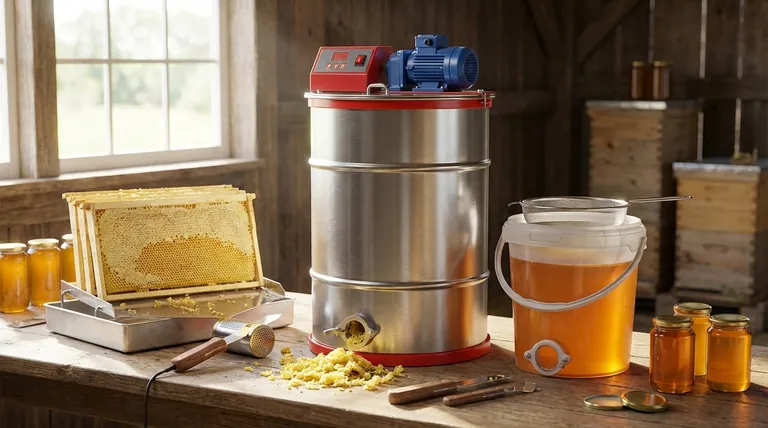
The Core Stages of Honey Processing
Understanding the process from comb to jar clarifies the function of each piece of equipment. The workflow is a logical sequence of separation and refinement.
Stage 1: Uncapping the Honeycombs
Before you can extract honey, you must remove the thin beeswax layer, known as "cappings," that bees build to seal each cell.
This is typically done with a heated uncapping knife or a specialized fork. The removed cappings, which are rich with honey, fall onto a capping tray or a simple food-safe tray to be drained or processed later.
Stage 2: Extracting the Honey
Extraction separates the liquid honey from the wax comb without destroying the comb itself, allowing bees to reuse it.
This is accomplished with a honey extractor, a machine that uses centrifugal force. Combs are placed in a basket that spins at high speed, flinging the honey out against the walls of the drum, from where it drains to the bottom.
Stage 3: Straining and Filtering
Raw honey from the extractor contains particles of wax, pollen, and other hive debris that must be removed.
The most basic method is passing the honey through a fine mesh strainer placed over a storage container. This removes larger particles. More advanced systems may use multiple, progressively finer filters.
Stage 4: Settling and Storage
After initial straining, honey benefits from a settling period. This allows air bubbles to rise to the top and any remaining fine particles to either rise or sink.
This is done in food-grade tanks or buckets, often called settling tanks. These containers typically have a spigot or "honey gate" near the bottom, allowing you to decant the clear honey from below the foam and above any sediment.
Stage 5: Bottling and Packaging
The final step is moving the clean, settled honey into its final containers.
This involves dispensing the honey from the settling tank's honey gate directly into food-safe jars with tight-fitting lids. For larger operations, automated packaging units handle this step.
Commercial Processing: Heating and Homogenization
For larger commercial packers, two additional steps are often included to ensure product consistency and ease of handling.
The Role of Gentle Heating
Commercial processors often gently warm honey to lower its viscosity (make it more fluid). This significantly speeds up fine filtration and bottling.
This is done in specialized jacketed tanks, where warm water circulates around the honey. This provides gentle, even heat exchange without creating hot spots that could damage the honey's delicate enzymes and flavors.
Why Homogenization Matters
For brands that mix honey from various sources, a homogenizer ensures a uniform product. It blends different batches to create a consistent flavor, color, and texture in every jar.
Understanding the Trade-offs
Choosing equipment involves balancing cost, efficiency, and the final product's characteristics. There is no single "best" setup.
Manual vs. Electric Extractors
A manual, hand-crank extractor is economical and perfect for hobbyists with a few hives. An electric extractor is significantly more expensive but is essential for medium to large-scale operations due to its higher capacity and efficiency.
The Risk of Over-Heating
While gentle heating aids processing, excessive heat is the enemy of quality honey. It can destroy beneficial enzymes, alter the flavor profile, and darken the color. Preserving the honey's natural state should always be the priority.
Straining vs. Filtering
Simple straining removes visible debris while leaving beneficial pollen in the honey. Aggressive, fine filtration can remove pollen, which some consumers prefer, but others see raw, unfiltered honey (with pollen) as a more natural and desirable product.
Making the Right Choice for Your Goal
Your equipment needs are directly tied to your operational scale and objectives.
- If your primary focus is a small hobbyist operation: Start with a manual extractor, an uncapping tray, a food-grade bucket with a honey gate, and a simple mesh strainer.
- If your primary focus is a growing sideline business: Invest in an electric extractor for efficiency and larger stainless steel tanks for settling larger batches.
- If your primary focus is a large commercial operation: You will need a full processing line, including automated uncapping machines, large-capacity extractors, heating and homogenization tanks, and automated bottling equipment.
Ultimately, the right equipment allows you to produce clean, high-quality honey efficiently at a scale that matches your ambition.
Summary Table:
| Processing Stage | Key Equipment | Purpose |
|---|---|---|
| Uncapping | Uncapping knife/fork, capping tray | Remove wax seals from honeycomb |
| Extraction | Manual or electric honey extractor | Separate honey from comb using centrifugal force |
| Straining/Filtering | Fine mesh strainer or multi-stage filters | Remove wax, pollen, and debris |
| Settling/Storage | Food-grade bucket/tank with honey gate | Allow air bubbles and fine particles to separate |
| Bottling/Packaging | Jars, lids, or automated bottling units | Dispense honey into final containers |
Ready to Scale Your Honey Production? Whether you're a hobbyist beekeeper or a commercial apiary, HONESTBEE supplies the durable, high-performance equipment you need—from manual extractors to full commercial processing lines. Our wholesale-focused operations ensure you get the best value on beekeeping supplies and equipment. Contact us today to discuss your specific needs and streamline your honey processing workflow!
Visual Guide
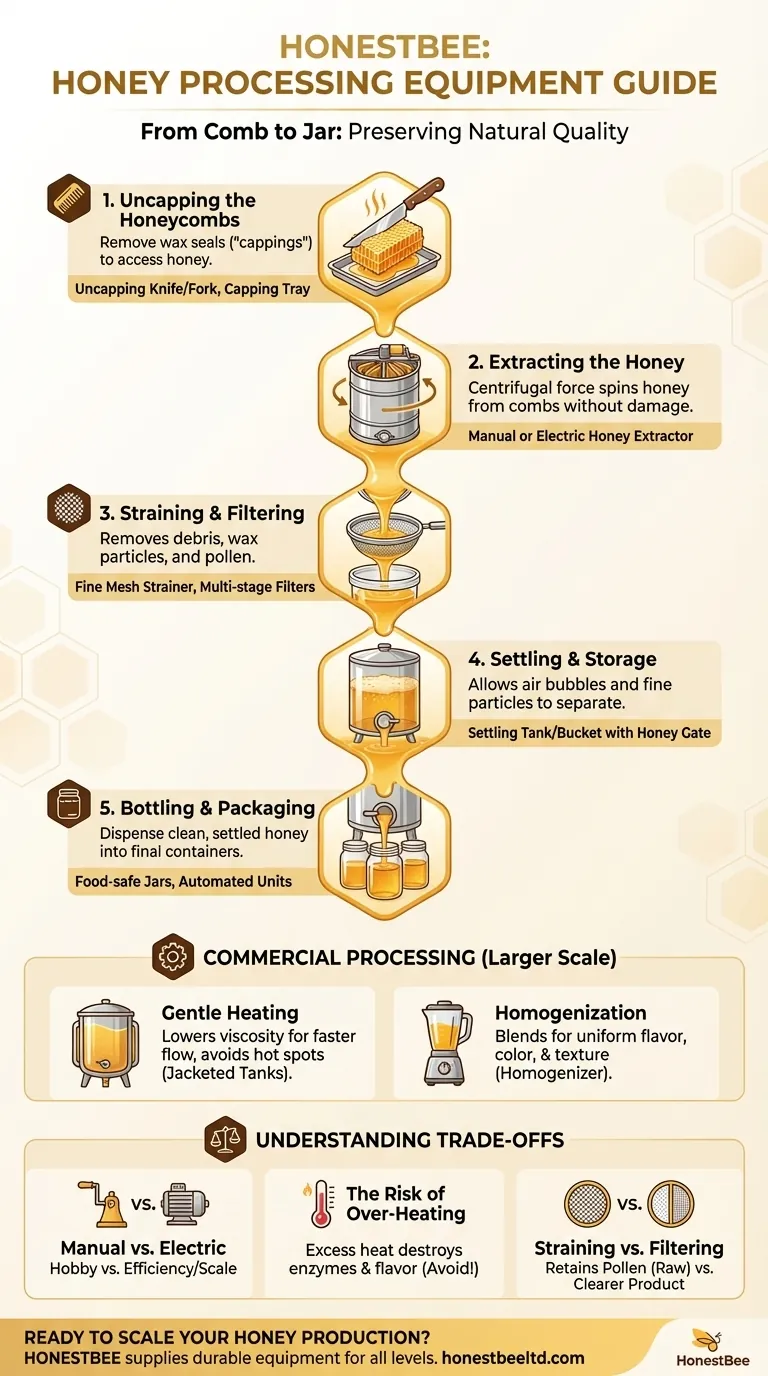
Related Products
- HONESTBEE 72 Frame Industrial Electric Honey Extractor for Beekeeping
- Electric 8 Frame Honey Spinner Extractor Equipment for Beekeeping
- 2 Frame Stainless Steel Manual Honey Spinner Extractor for Beekeeping
- 8-Frame Electric Self-Reversing Honey Extractor Spinner for Commercial Honey Extraction Equipment
- HONESTBEE 6 Frame Self Reversing Electric Honey Extractor for Beekeeping
People Also Ask
- Why is preserving honeycomb integrity important, and how do automated extractors help? Boost Hive Health & Honey Yields
- What is the energy consumption like for automatic honey extractors? Maximize Your Harvest Efficiency
- What are the advantages of automated honey extractors in terms of time efficiency? Boost Your Harvest Speed
- What are the advantages of automatic honey extractors? Scale Your Apiary with Unmatched Efficiency
- Can a manual extractor be upgraded to an electric one? Save Labor & Boost Efficiency




